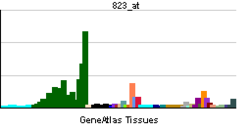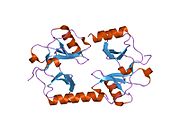CX3CL1
| edit |
| Hemokin (C-X3-C motiv) ligand 1 | |||||||||||
|---|---|---|---|---|---|---|---|---|---|---|---|
| Dostupne strukture | |||||||||||
| 1b2t, 1f2l | |||||||||||
| Identifikatori | |||||||||||
| Simboli | CX3CL1; NTN; ABCD-3; C3Xkine; CXC3; CXC3C; NTT; SCYD1; fractalkine; neurotactin | ||||||||||
| Vanjski ID | OMIM: 601880 MGI: 1097153 HomoloGene: 2251 GeneCards: CX3CL1 Gene | ||||||||||
| |||||||||||
| Pregled RNK izražavanja | |||||||||||
 | |||||||||||
 | |||||||||||
| podaci | |||||||||||
| Ortolozi | |||||||||||
| Vrsta | Čovek | Miš | |||||||||
| Entrez | 6376 | 20312 | |||||||||
| Ensembl | ENSG00000006210 | ENSMUSG00000031778 | |||||||||
| UniProt | P78423 | Q8C9Y1 | |||||||||
| RefSeq (mRNA) | NM_002996 | NM_009142 | |||||||||
| RefSeq (protein) | NP_002987 | NP_033168 | |||||||||
| Lokacija (UCSC) | Chr 16: 55.96 - 55.98 Mb | Chr 8: 97.66 - 97.67 Mb | |||||||||
| PubMed pretraga | [1] | [2] | |||||||||
CX3CL1, hemokin (C-X3-C motiv) ligand 1, je veliki citokin protein sa 373 aminokiseline. On sadrži više domena. Ovo je jedini član CX3C hemokin familije. On je poznat pod imenima fraktalkin (kod ljudi) i neurotaktin (kod miševa).[1][2] Polipeptidna struktura CXC3L1 se razlikuje od tipične strukture drugih hemokina. Na primer, razmak između karakterističnih N-terminalnih cisteina je različit; postoje tri aminokiseline između inicijalnog para cisteina u CX3CL1, koji se ne javljaju u CC hemokinima. Postoji samo jedna aminokiselina u tom segmentu CXC hemokina. CX3CL1 se proizvodi kao dugački protein (sa 373 aminokiseline kod ljudi) sa produženim poput mucina stablom i hemokin domenom na vrhu. Mucinu-slično stablo dozvoljava mu da se veže na površinu pojedinih ćelija. Rastvorna (90 kD) verzija ovog hemokina takođe je bila primećena. Rastvorni CX3CL1 je potencijalni hemoatraktant T ćelija i monocita, dok hemokin vezan za ćeliju promoviše snažnu adheziju leukocita na aktivirane endotelne ćelije, gde je on prvenstveno izražen.[2] CX3CL1 izaziva svoje adhezivne i migratorne funkcije putem interakcija sa hemokin receptorom CX3CR1.[3] Njegov gene je lociran na ljudskom hromozom 16 zajedno sa nekim CC hemokinima poznatim kao CCL17 i CCL22.[2][4][5]
Reference
- ↑ Pan et al. (1997). „Neurotactin, a membrane-anchored chemokine upregulated in brain inflammation”. Nature 387: 611-617.
- ↑ 2,0 2,1 2,2 Bazan et al. (1997). „A new class of membrane-bound chemokine with a CX3C motif”. Nature 385: 640-644.
- ↑ Imai et al. (1997). „Identification and molecular characterization of fractalkine receptor CX3CR1, which mediates both leukocyte migration and adhesion”. Cell 91: 521-530.
- ↑ Nomiyama et al. (1998). „Human chemokines fractalkine (SCYD1), MDC (SCYA22) and TARC (SCYA17) are clustered on chromosome 16q13. Cytogenet”. Cell Genet 81: 10-11.
- ↑ Mire-Sluis, Anthony R.; Thorpe, Robin, ur. (1998). Cytokines (Handbook of Immunopharmacology). Boston: Academic Press. ISBN 0-12-498340-5.
Literatura
- Umehara H, Bloom ET, Okazaki T, et al. (2004). „Fractalkine in vascular biology: from basic research to clinical disease.”. Arterioscler. Thromb. Vasc. Biol. 24 (1): 34–40. DOI:10.1161/01.ATV.0000095360.62479.1F. PMID 12969992.
- Umehara H, Tanaka M, Sawaki T, et al. (2006). „Fractalkine in rheumatoid arthritis and allied conditions.”. Mod Rheumatol 16 (3): 124–30. DOI:10.1007/s10165-006-0471-9. PMID 16767549.
- Maruyama K, Sugano S (1994). „Oligo-capping: a simple method to replace the cap structure of eukaryotic mRNAs with oligoribonucleotides.”. Gene 138 (1-2): 171–4. DOI:10.1016/0378-1119(94)90802-8. PMID 8125298.
- Bazan JF, Bacon KB, Hardiman G, et al. (1997). „A new class of membrane-bound chemokine with a CX3C motif.”. Nature 385 (6617): 640–4. DOI:10.1038/385640a0. PMID 9024663.
- Pan Y, Lloyd C, Zhou H, et al. (1997). „Neurotactin, a membrane-anchored chemokine upregulated in brain inflammation.”. Nature 387 (6633): 611–7. DOI:10.1038/42491. PMID 9177350.
- Suzuki Y, Yoshitomo-Nakagawa K, Maruyama K, et al. (1997). „Construction and characterization of a full length-enriched and a 5'-end-enriched cDNA library.”. Gene 200 (1-2): 149–56. DOI:10.1016/S0378-1119(97)00411-3. PMID 9373149.
- Imai T, Hieshima K, Haskell C, et al. (1997). „Identification and molecular characterization of fractalkine receptor CX3CR1, which mediates both leukocyte migration and adhesion.”. Cell 91 (4): 521–30. DOI:10.1016/S0092-8674(00)80438-9. PMID 9390561.
- Nomiyama H, Imai T, Kusuda J, et al. (1998). „Human chemokines fractalkine (SCYD1), MDC (SCYA22) and TARC (SCYA17) are clustered on chromosome 16q13.”. Cytogenet. Cell Genet. 81 (1): 10–1. DOI:10.1159/000015000. PMID 9691168.
- Combadiere C, Salzwedel K, Smith ED, et al. (1998). „Identification of CX3CR1. A chemotactic receptor for the human CX3C chemokine fractalkine and a fusion coreceptor for HIV-1.”. J. Biol. Chem. 273 (37): 23799–804. DOI:10.1074/jbc.273.37.23799. PMID 9726990.
- Meucci O, Fatatis A, Simen AA, et al. (1998). „Chemokines regulate hippocampal neuronal signaling and gp120 neurotoxicity.”. Proc. Natl. Acad. Sci. U.S.A. 95 (24): 14500–5. DOI:10.1073/pnas.95.24.14500. PMC 24402. PMID 9826729.
- Mizoue LS, Bazan JF, Johnson EC, Handel TM (1999). „Solution structure and dynamics of the CX3C chemokine domain of fractalkine and its interaction with an N-terminal fragment of CX3CR1.”. Biochemistry 38 (5): 1402–14. DOI:10.1021/bi9820614. PMID 9931005.
- Papadopoulos EJ, Sassetti C, Saeki H, et al. (1999). „Fractalkine, a CX3C chemokine, is expressed by dendritic cells and is up-regulated upon dendritic cell maturation.”. Eur. J. Immunol. 29 (8): 2551–9. DOI:10.1002/(SICI)1521-4141(199908)29:08<2551::AID-IMMU2551>3.0.CO;2-T. PMID 10458770.
- Loftus BJ, Kim UJ, Sneddon VP, et al. (1999). „Genome duplications and other features in 12 Mb of DNA sequence from human chromosome 16p and 16q.”. Genomics 60 (3): 295–308. DOI:10.1006/geno.1999.5927. PMID 10493829.
- Tong N, Perry SW, Zhang Q, et al. (2000). „Neuronal fractalkine expression in HIV-1 encephalitis: roles for macrophage recruitment and neuroprotection in the central nervous system.”. J. Immunol. 164 (3): 1333–9. PMID 10640747.
- Faure S, Meyer L, Costagliola D, et al. (2000). „Rapid progression to AIDS in HIV+ individuals with a structural variant of the chemokine receptor CX3CR1.”. Science 287 (5461): 2274–7. DOI:10.1126/science.287.5461.2274. PMID 10731151.
- Hoover DM, Mizoue LS, Handel TM, Lubkowski J (2000). „The crystal structure of the chemokine domain of fractalkine shows a novel quaternary arrangement.”. J. Biol. Chem. 275 (30): 23187–93. DOI:10.1074/jbc.M002584200. PMID 10770945.
- Meucci O, Fatatis A, Simen AA, Miller RJ (2000). „Expression of CX3CR1 chemokine receptors on neurons and their role in neuronal survival.”. Proc. Natl. Acad. Sci. U.S.A. 97 (14): 8075–80. DOI:10.1073/pnas.090017497. PMC 16672. PMID 10869418.
- Papadopoulos EJ, Fitzhugh DJ, Tkaczyk C, et al. (2000). „Mast cells migrate, but do not degranulate, in response to fractalkine, a membrane-bound chemokine expressed constitutively in diverse cells of the skin.”. Eur. J. Immunol. 30 (8): 2355–61. DOI:10.1002/1521-4141(2000)30:8<2355::AID-IMMU2355>3.0.CO;2-#. PMID 10940926.
- Lucas AD, Chadwick N, Warren BF, et al. (2001). „The transmembrane form of the CX3CL1 chemokine fractalkine is expressed predominantly by epithelial cells in vivo.”. Am. J. Pathol. 158 (3): 855–66. PMC 1850344. PMID 11238035.
- Garton KJ, Gough PJ, Blobel CP, et al. (2001). „Tumor necrosis factor-alpha-converting enzyme (ADAM17) mediates the cleavage and shedding of fractalkine (CX3CL1).”. J. Biol. Chem. 276 (41): 37993–8001. DOI:10.1074/jbc.M106434200. PMID 11495925.
- p
- r
- u
| |||||||||||||||
| |||||||||||||||
| |||||||||||||||







